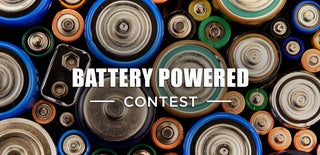Introduction: Magnetohydrodyamic Submarine
In the movie, The Hunt for Red October, a renegade Soviet Submarine has a new silent drive propulsion system. They call it Magneto-hydrodynamic propulsion. That sounds like Hollywood technobabble, but it's actually based in reality (mostly). We recreate this type of submarine with some 3D printed parts, batteries and some magnets.
Supplies
Some #4 screws and nuts
AA Batteries
Two BY0X08, 2" x 1" x 1/2", neodymium magnets
Some electrical wire
Aluminum/stainless steel plates
3D Printed Parts (STL Files)
Step 1: 3D Print Parts
We've included the STL files in the supplies list! Or, design your own!
We designed a bracket that holds two pieces of aluminum on either side of a rectangular passageway. The model also has provisions for positioning two large block magnets above and below the passageway.
We used a two part assembly, where the top snaps onto the bottom. Since the top magnet is in the top half of the hull, this worked nicely to allow the strong attractive force between these powerful magnets to pull the halves together. It didn't require any other method of securing them.
The submarine in the movie had a dual propulsion system. We only have one drive, but we designed two inlets and outlets to give it the dual drive look.
The top and lower shells each took over 12 hours to print on our MakerBot.
Using the bracket drawing as a guide, bend some thin aluminum or stainless steel into the "L" shape as shown.
Step 2: Saltwater Test
Before going any further, we filled a smaller container with water and mixed in a bunch of salt to test how our submarine works.
We assembled the drive bracket, with the aluminum brackets and magnets. With the drive assembly in saltwater, hooked up to a power supply, it really moves some water!
Step 3: Assembly
The assembly is pretty straight forward. Start by fastening the conductive plates to the drive bracket. We used brass nuts to hold the wires in place as well.
Insert the drive bracket assembly into the lower shell, fastening with more brass screws and nuts.
Next, wire in the switch. See the schematic for wiring directions!
We designed the sub in such a way that that the pieces are held together by the attracting magnet. Place one magnet in the top assembly and one in the bottom. This provided enough force to hold the pieces together.
Next, we wrapped the battery pack in many layers of packing tape in an attempt to waterproof it...a Ziplock baggie might be better. The bottom magnet holds the battery pack in place.
Step 4: Final Test
For our final test, we filled an aquarium with about 20 gallons of water and added a lot of salt. For our first test, the salt level was about 3.5%, which is typical of our oceans. It worked!! It was slow going, but the submarine was definitely being propelling by batteries and magnets.
To make the submarine go even faster, we mixed in even more salt. With the salt level near 30%, which is the level of the Dead Sea, the submarine moved faster! Check out the video for the start to finish process.
Step 5: This Is Cool, But How/why Does It Work?
Salty water conducts electricity. Imagine a drive tube with two conductive plates secured on opposite sides of the tube. With one grounded and the other connected to a voltage, a current flows through the water across the gap.
The resistance of the water changes depending on how much salt is dissolved in it. The more salt, the more current you’ll get. Since submarines operate in the ocean, we’ll assume the operating fluid is seawater, roughly 3.5% salt by weight.
Next, we’ll place two magnets sandwiching the tube, top and bottom. Now the water within sees vertical magnetic field.
Finally, let’s consider the Lorentz force. Consider what's happening to a tiny little bit of conductive water within that tube. The right hand rule says that, with a current flowing in one direction, and a magnetic field runs in a direction perpendicular to that electric flow, then the bit of water will feel a force that’s perpendicular to both of those directions.
Whew, that’s a mouthful. Let’s express that graphically with the right-hand rule. If the current runs in the direction of the thumb, and the magnetic field with the index finger, the force is down the middle finger.
Science for the win!!!

Participated in the
Battery Powered Contest











